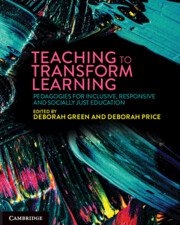Book contents
- Teaching to Transform Learning
- Acknowledgement of Country
- Teaching to Transform Learning
- Copyright page
- Contents
- Contributors
- Acknowledgements
- Introduction Understanding the learner to inform educators’ implementation of pedagogical approaches to transform learning
- Part 1 Pedagogies for all
- Part 2 Engaging pedagogies: making the curriculum come alive for all learners
- 8 Redesigning pedagogy for transformation: creative body-based learning
- 9 Building transformative classrooms through visual and creative body-based learning design
- 10 Co-constructed early childhood pedagogies
- 11 Strengths-based, learner-centred pedagogies: the voice of learners in co-creation and co-design
- 12 Pedagogy informed by community expertise
- 13 Nature-based approaches enhancing experiential learning
- 14 Beyond the four walls
- Part 3 Empowering pedagogies: 21st-century skill development and 22nd-century futures thinking
- Index
- References
13 - Nature-based approaches enhancing experiential learning
from Part 2 - Engaging pedagogies: making the curriculum come alive for all learners
Published online by Cambridge University Press: 25 October 2024
- Teaching to Transform Learning
- Acknowledgement of Country
- Teaching to Transform Learning
- Copyright page
- Contents
- Contributors
- Acknowledgements
- Introduction Understanding the learner to inform educators’ implementation of pedagogical approaches to transform learning
- Part 1 Pedagogies for all
- Part 2 Engaging pedagogies: making the curriculum come alive for all learners
- 8 Redesigning pedagogy for transformation: creative body-based learning
- 9 Building transformative classrooms through visual and creative body-based learning design
- 10 Co-constructed early childhood pedagogies
- 11 Strengths-based, learner-centred pedagogies: the voice of learners in co-creation and co-design
- 12 Pedagogy informed by community expertise
- 13 Nature-based approaches enhancing experiential learning
- 14 Beyond the four walls
- Part 3 Empowering pedagogies: 21st-century skill development and 22nd-century futures thinking
- Index
- References
Summary
This chapter presents a synthesis of two key constructs: nature-based approaches and experiential learning. The first part of this chapter presents an overview of nature-based approaches. Research perspectives are presented to outline the importance of natural spaces in nurturing children and young people’s wellbeing, connection with nature, development of ecological awareness and holistic engagement with learning. Experiential learning theory is defined and described to examine the transformational potential of learning experienced outdoors. The interactive relationship and theoretical perspectives underlying experiential approaches are presented.
The second part of this chapter presents discussion on nature-based programs such as Forest Schools, Bush Kinders and Schools, and Nature/Environmental Kindergartens and Schools. Case studies will provide authentic contexts to highlight key aspects of intentional practice that enhance experiential learning and inquiry in nature-based settings. Finally, a synthesis of enabling practice is presented to further consider specific pedagogical implications underlying nature based approaches.
Keywords
- Type
- Chapter
- Information
- Teaching to Transform LearningPedagogies for Inclusive, Responsive and Socially Just Education, pp. 203 - 218Publisher: Cambridge University PressPrint publication year: 2024

